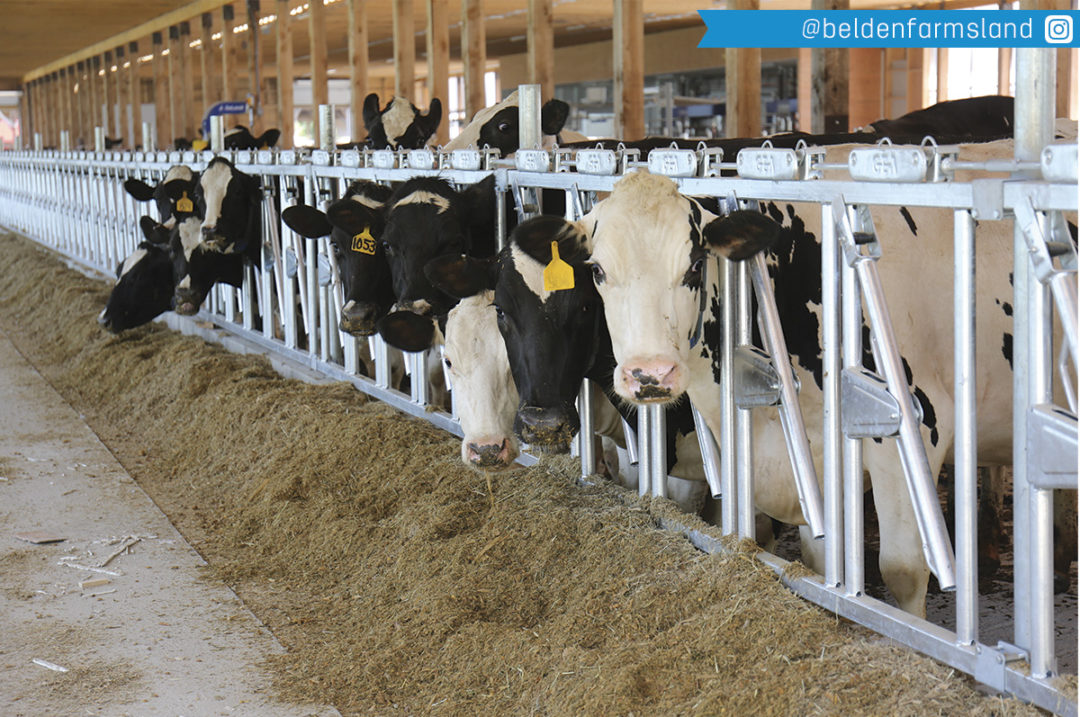The economic cost and impact of feed shrink on dairy farms is a widely covered topic. Sources of clearly measurable feed shrink include field losses, improper storage, feedout practices, wind, rain, birds, wildlife and heating of the total mixed ration (TMR). However, there are some unseen forms of feed shrink that have a significant impact on the nutrient value of a cow’s diet. This unseen shrink is not easily measured, comes from certain ingredients and storage conditions, and can happen over days, weeks and months.
One form of unseen shrink is the degradation of fat-soluble vitamins supplemented in rations to improve a cow’s health and well-being. Fat-soluble vitamins are essential nutrients with a diverse variety of functions. They function as cofactors or coenzymes in many metabolic pathways and improve immune function and regulation of gene expression. Fat-soluble vitamins are often overlooked in the ration. They are small in the amount needed but large in the effect on animal health and performance. How important are fat-soluble vitamins in a cow’s diet? The recent eighth edition of the Nutrient Requirements of Dairy Cattle, published by the National Academies of Sciences, Engineering and Medicine (NASEM), increased daily requirements of vitamin A by 20% and vitamin D by 40% for lactating cows, and for dry cows, the daily vitamin E requirement was almost doubled. Taken together, these changes suggest that we have likely been underfeeding vitamins for many years.
The antioxidant properties of fat-soluble vitamins make them key in a variety of bodily functions. Vitamin A plays a role in vision, bone formation, reproduction, immune function and prevention of infections – particularly mastitis. Vitamin D functions in normalizing plasma concentrations of calcium and phosphorus, which are important in the prevention of hypocalcemia (i.e., milk fever), and affects immune function. Vitamin E is the most powerful antioxidant of the three vitamins, and it has major roles in disease resistance (i.e., immune function), prostaglandin formation and tissue protection. All of these biological activities are critical for the health of dairy cows.
The unseen shrink of fat-soluble vitamins comes from their loss of biological activity over time due to degradation. Fat-soluble vitamins are degraded by a variety of factors including heat, oxygen, moisture (i.e., humidity), light (i.e., UV radiation), acid or alkali conditions and exposure to certain forms of trace minerals. These conditions degrade both natural sources found in dietary forages and grains and synthetic forms supplemented in the diet. In fact, as the use of ensiled and byproduct feeds has increased in dairy diets, NASEM has so greatly discounted fat-soluble vitamins from feeds that they recommend full supplementation of synthetic fat-soluble vitamins to meet requirements.
Most vitamins supplemented in TMRs are provided in a vitamin-trace mineral mix to reduce individual additions and increase the precision feeding of these expensive ingredients. Cows only need milligram amounts of fat-soluble vitamins to meet their requirements, and, even on large farms, accurately mixing these small amounts in the mixer wagon is practically impossible. Additionally, as the price of feed has increased over the years, the cost of fat-soluble vitamins has remained among the highest on a per-pound basis, which makes accurate feeding and reducing degradation in the diet financially important.
The effects of heating, oxygen exposure, moisture, light and acid or alkali conditions on the degradation of fat-soluble vitamins seem straightforward, as dairy farmers continually fight these conditions in preserving forages and grains for their herds. But how does the form of trace minerals in a vitamin-trace mineral mix cause vitamin degradation? Trace minerals – including copper (Cu), zinc (Zn) and manganese (Mn) – come in different forms, and these different forms have varying levels of solubility and reactivity. The more soluble and more reactive the form of the trace mineral, the more likely that trace mineral will degrade a vitamin.
The most soluble and reactive forms of trace minerals in dairy rations are those combined with sulfate (SO4) – copper sulfate (CuSO4), zinc sulfate (ZnSO4) and manganese sulfate (MnSO4). When these trace minerals are exposed to any amount of moisture, the metal (e.g., copper, zinc or manganese) easily separates from its sulfate ligand, creating a free metal ion, which is the major concern. Free metal ions are positively charged particles that rapidly attach to and degrade biological material. A clear example, used every day on dairy farms, is the copper sulfate footbath, where the free metal ion (in this case, Cu2+) kills the bacteria that cause hairy heel warts. But, in the case of vitamins, where we want to maintain biological activity, degradation caused by free metal ions from sulfate trace minerals is a major problem. Figure 1 illustrates this problem by showing that when 200 parts per million (ppm) copper from copper sulfate was supplemented in poultry feed, vitamin E level dropped 24%-69% after 10-41 days of storage compared to the control group with no added copper.

This unseen shrink is avoidable. Replacing the sulfate trace mineral with low-solubility, low-reactivity trace mineral will reduce the degradation of vitamins over time, increasing biological activity. Hydroxychloride trace minerals are a form of trace minerals where the metal (e.g., copper, zinc or manganese) is covalently bonded to chloride ions, resulting in a compound low in solubility and reactivity. Referring to Figure 1, when hydroxychloride copper (i.e., IntelliBond C) was incorporated into the poultry feed, the level of vitamin E over time was almost identical to the control where no copper was added. These results indicate that hydroxychloride trace minerals can be used in vitamin-trace mineral mixes to protect fat-soluble vitamins.
Vitamin nutrition in dairy rations is often taken for granted, with little recognition of factors that lead to vitamin degradation – an unseen form of shrink. The 2021 NASEM Nutrient Requirements of Dairy Cattle recommends increasing the supplemental levels of fat-soluble vitamins to improve cow health and performance. Utilizing hydroxychloride trace minerals in your dairy’s vitamin-trace mineral mix will ensure that those vitally important and expensive vitamins will be available to the cow throughout her lactation cycle.
References omitted but are available upon request. Click here to email an editor.







